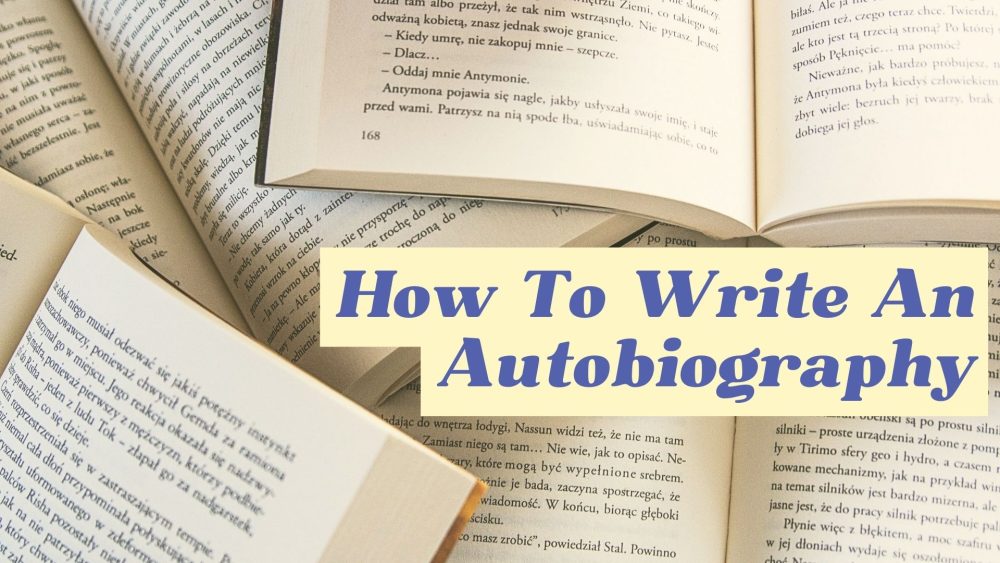How To Write An Autobiography Guideline And Useful Advice
June 21, 2023
Many people want to know how to write an autobiography to take their place in history or make a mark. This writing helps you list life’s essential milestones, moments, places, and people. It enables you to use your voice to share your story. This article defines an autobiography while explaining how to write it. Also, it shares practical tips for writing a good autobiography. It’s essential because many educators assign students this task, yet most needs help writing an autobiography.

Table of Contents
What Is An Autobiography?
An autobiography is a narration by the author depicting their life story chronologically. An autobiography can fall under any of these categories, depending on the purpose:
- Autobiographical College Essay
Some institutions require students to submit an educational autobiography with their college application. It enables students to present themselves to the admission officers while persuading them to accept them into their institutions. - Personal Essay
A personal essay is a short autobiography. It’s a self-portrait essay that is more emotional and personal, sharing the author’s experiences. Typically, this essay focuses on a specific period, event, or individual. It’s a common assignment in high school and college. - Memoir
A memoir is an autobiography that doesn’t necessarily cover the writer’s life. It focuses on the most significant and exciting past events, covering as much information as possible.
Comprehensive autobiographies are lengthy and through accounts of the authors’ lives. They cover everything from birth to the current moments.
What Is The Goal Of An Autobiography?
An autobiography gives a firsthand account of the writer’s life. It provides a higher intimacy level for the readers. This writing can serve the following purposes:
- Convey the writer’s life story to a significant audience
- Help the author leave a mark
- Reconcile the author’s past
- Preserve the author’s memories
The primary purpose of an autobiography is to portray the writer’s achievements and experiences. That’s why most people write autobiographies later in life to give firsthand accounts describing their stories.
What To Include In An Autobiography
The first question many ask when planning to write an autobiography is what to include in their composition. And this concern is vital since you must know what to put in a autobiography and what to avoid including in your life story. For instance, you can only focus on some details or every people you’ve met. Otherwise, you will make the autobiography longer than necessary. Here’s a breakdown of what to write about in an autobiography.
- Significant events: You may include important life events, including your origin, life lessons, life-turning points, vacations, and graduations.
- Milestones: Talk about your successes and achievements in life.
- Vital people: Talk about family, friends, coaches, mentors, teachers, and business partners. Share information about the people that affected you the most.
- Emotional moments: Share details of the challenges you’ve faced when you faced a life-threatening illness, when you were struggling financially, and when you met your spouse.
- Suspense and drama: How did you feel when your first baby was born? Did you go through surgery? Did you secure admission to your dream college?
Consider a movie trailer when planning, organizing, and writing an autobiography. You can include highly emotional moments and significant events or major characters.
How To Start An Autobiography
Since an autobiography describes a person’s story, it should start with their origin, including family members, hometown, and educational background. However, ensure you only include relevant details in your story. Here’s a breakdown of the autobiography writing process.
Starting an autobiography involves selecting or creating a compelling title. So, avoid generic phrases and create an engaging heading for the story. To do this, follow these steps:
- Read Well-Known Autobiographies
Many prominent people, including successful artists, business people, politicians, and writers, have written autobiographies. You can read autobiographies of inspiring personalities to get the basics of autobiographical writing. - Think about Your Life
Remember unusual experiences, significant events, and essential people in your life. Please consider your life and the worthy moments to include in the autobiography. You can talk to people who know some of the outstanding things you’ve done. - Make a List
Making a list is vital when writing your autobiography. The list should categorize your memories to enable you to structure thoughts logically. Making this list can be challenging for adults with active lifestyles. Nevertheless, focus on events and individuals your readers will find interesting. - Brainstorm
Once you’ve chosen a topic, people, and events to include, think about fantastic ideas for autobiography. The following question should help you select the aspects to consider:- What was the worst or best part of a person or event you want to talk about in your autobiography?
- What information should you share with your readers?
- What feelings or moods do you want your readers to get when or after reading your autobiography?
- How did that particular event change your life?
- What lessons did somebody or an event teach you?
- What made a specific event or moment important in your life?
- Why did you choose to share this particular event with the readers?
- Why is now the best moment to write the autobiography?
Planning is vital when writing an autobiography. Therefore, think carefully about various aspects of the people in your life before writing it.
How To Write A Good Autobiography Of Yourself
To make your life story fascinating, understand the autobiography structure before you start writing. Here are the primary sections to add to your autobiography.
- Introduction
The introduction should introduce the topic and present your core ideas. Here’s what your autobiography introduction should do:- Introduce your title to the readers
- Present your core ideas
- Capture the readers’ attention
Ensure your introductory paragraph makes the readers want to read further. Please make it straight to the point and concise, ranging from one to three sentences. You may outline a general portrait and make intriguing statements to encourage your readers to proceed reading past the introduction.
- Body
The autobiography’s body is the most significant section because it’s where you tell the story. There are no specific requirements for this section regarding the length. So, make it as long as necessary to uncover your life’s main events. However, ensure the text in this section is:- Transparent: Make following and understanding the text easy for the readers.
- Well-structured: Focus every paragraph on a particular period, time, or event.
- Logical: Ensure you present facts logically with smooth transitions from one section to the next.
- Conclusion
Your autobiography conclusion should leave a lasting impression since the introduction made the readers interested in reading it. In this section, assess your life and the lessons you have learned. Also, tell your readers how the life lessons helped you. Nevertheless, ensure your conclusion is concise and clear.
Sample Autobiography Template
Writing an autobiography outline is vital when planning how to complete this task. Here’s a sample template for writing an autobiography.
- Premise
The autobiography premise should revolve around the main idea. You can make it your autobiography theme and use it to keep your text relevant. Here’s an example premise:“This autobiography explains how a man overcame homelessness and depression to excel in the corporate world.”
- Setting
Setting up a scene helps create a frame for the story. It describes the place and time of the events. Here’s an example:“I was born in Africa during the great recession.”
- Characters
Ensure the people that played a vital role in your life gets a proper introduction. And these can include your parents, spouse, or friends. For instance, you can say the following about your parents.“I had a busy father because my grandparents taught him that only hard work could keep him alive.”
- Plot
You can write your autobiography by creating a simple plot that lets you fill in the blanks. It will help you know the catalyst, journey, and destination. It provides a narrative arc for the story and should include the following:- The beginning: This should have an introduction, history, and settings.
- Middle: Include this section’s main events, highlights, and conflict.
- End: Have the main thoughts, reflections, and ending remarks in this section.

Tips On Writing An Autobiography
Whether you want to write an autobiography essay or an autobiographical book, you will find the following tips helpful when completing this task.
- Write Chronologically
Ensure your story follows a chronological order to make the task more manageable. That way, you will focus on each season after the other rather than jump around. Also, it creates a natural flow for the story, making reading a smooth experience. - Describe Memories
Your story may only include a few action scenes. However, detailed descriptions can spark the readers’ imaginations. Therefore, be creative when describing personal memories. And you can capture the human senses with your illustrations. For instance, you can tell readers about the taste of food, the smell of coffee, or the sound of someone’s voice. Sensory writing enables you to establish colorful expressions even when describing something simple. - Hook Readers with the Introduction
Engaging your readers from the beginning is vital when writing an autobiography. Therefore, aim to convince your readers that your autobiography is worth reading and distinctive. You can play on their curiosity or nostalgia to ensure they continue reading. - Include Real Names of Events and People
The writer’s autobiography should include real names of places, people, and events. Disclosing real names enables the readers to connect more with your story since it makes it richer. It gives the autobiography authenticity. If you’ve forgotten an event or a person’s name, describe them in your text. However, mention only relevant events and people. - Be Specific with Dates, Times, and Places
Ensure your autobiography paints a picture for your readers by providing detailed and vivid descriptions. For instance, rather than say.”“It was getting dark, and I was cold.”
You can say:
“It was around 9 pm when I waited for him to arrive by the beautiful church on Christmas Eve. There were no stars or the moon that night. I could only see a street lamp about three blocks away.”
Make your description more colorful so that your readers can find it enjoyable. Listing specific dates, times, and places is an effective technique. And you may expand on them as you continue writing the autobiography.
- Include Reflections
Reflections enable the author to be honest about various things in life. That’s why some autobiographies give them more gravity than the stories. Here, you can express your joys, frustrations, and feelings about various aspects of life. But that doesn’t mean explaining how you thought or felt about everything. Instead, you may limit the reflections to the most significant events only. Also, ensure readers get the primary takeaway from the autobiography through your examinations. For instance, what lessons or insights did you learn from the events? That way, you can drive the points home, and readers will love to know them too. - Find Your Unique Voice
A personal voice is vital when writing your life’s story. Ensure you use a tone you’re comfortable with or compose mini-drafts in various approaches to find one that suits you. Finding a unique voice early ensures a consistent style for the entire autobiography. Also, it eliminates the need to edit the whole autobiography. - Use Images
You can use images to emphasize your story’s season. When your autobiography has more photos, it becomes more colorful. Also, you can use pictures to break up text blocks or provide a visual texture to the autobiography. However, insert only meaningful photos with sentimental value. - Make it Short
Consider your readers, who could be your professor, a scholarship committee judge, or an admission officer. These people are busy with hundreds or thousands of autobiographies to read. Therefore, ensure only vital details go into your autobiography. If you want to ensure your autobiography is of the correct length, ask your impatient friend to read it. They will provide an honest opinion since they prefer reading short articles to long stories or books. - Avoid Making It a Personal Diary
Your autobiography should be candid, revealing, and precisely honest. Also, describe your life’s hardships to show how you overcame them and their influence on you. However, write the things you feel calm discussing. For instance, if students made fun of you in college and you feel like killing them, you may avoid the topic. That’s because your feelings could leak into the text and make readers subconsciously uncomfortable.
Use a Custom Writing Service
Do you need help writing an autobiography? If so, you can hire our customized term papers experts online. Our professional writers have helped many students write winning autobiographies. If your teacher assigned you an autobiography assignment and you need help from a native English speaker to excel in your course, we can assist you.
We deliver top-quality written assignments to learners at all educational levels. Whether in high school or university, we can write an autobiography to help you become the best student in your class. Our services are cheap, and we can even help you generate ideas for the text. Moreover, we can help you beat the submission deadline, no matter the urgency of your assignment. Please get in touch with us to order your autobiography. We will gladly help you write a winning autobiography paper!
FAQ
How do I start writing an autobiography?
Start by gathering as many facts and details about your life as possible to help readers understand what has been happening. Next, please choose a topic, introduce it to the readers, and discuss the prominent people and events in the body. End the autobiography with a conclusion wrapping up everything.
Is there a specific format for an autobiography?
No. Most autobiographies use the same format as traditional personal memoirs, graphic novels, dramas, vignettes, and scripts. Therefore, choose a format that works best for you, depending on the length, scope, and what the autobiography is meant for. You might be writing it as a scholarship application, for which you can get a scholarship essay writing service any time!
How long should an autobiography be?
No specific lengths or rules about an autobiography’s word count or size exist. However, most autobiographies range between 250 and 450 pages. If you’re writing an educational autobiography, your teacher or institution may specify the length. If not, ensure your autobiography is sufficiently long to cover your life’s vital details.
What topics should I include in an autobiography?
Your autobiography should include only vital topics. For instance, cover things like your place and time of birth, your personality overview, and something you like and dislike. Also, explain special events that have helped shape your life and the lessons they taught you.
Take a break from writing.
Top academic experts are here for you.
- How To Write An Autobiography Guideline And Useful Advice
- 182 Best Classification Essay Topics To Learn And Write About
- How To Manage Stress In College: Top Practical Tips
- How To Write A Narrative Essay: Definition, Tips, And A Step-by-Step Guide
- How To Write Article Review Like Professional












